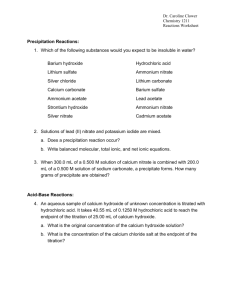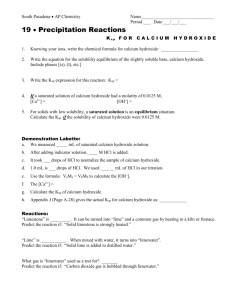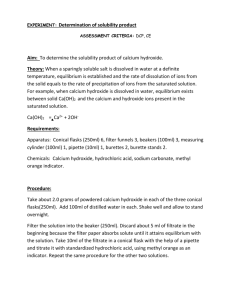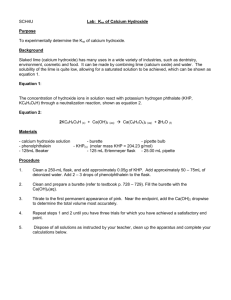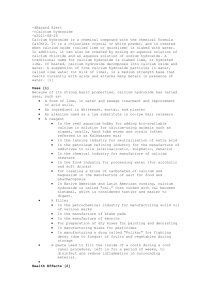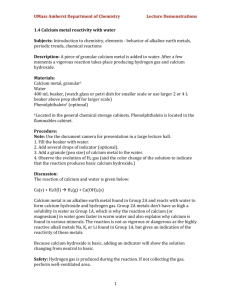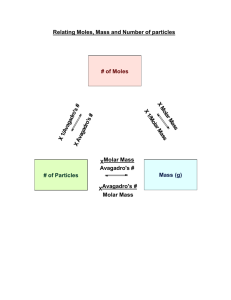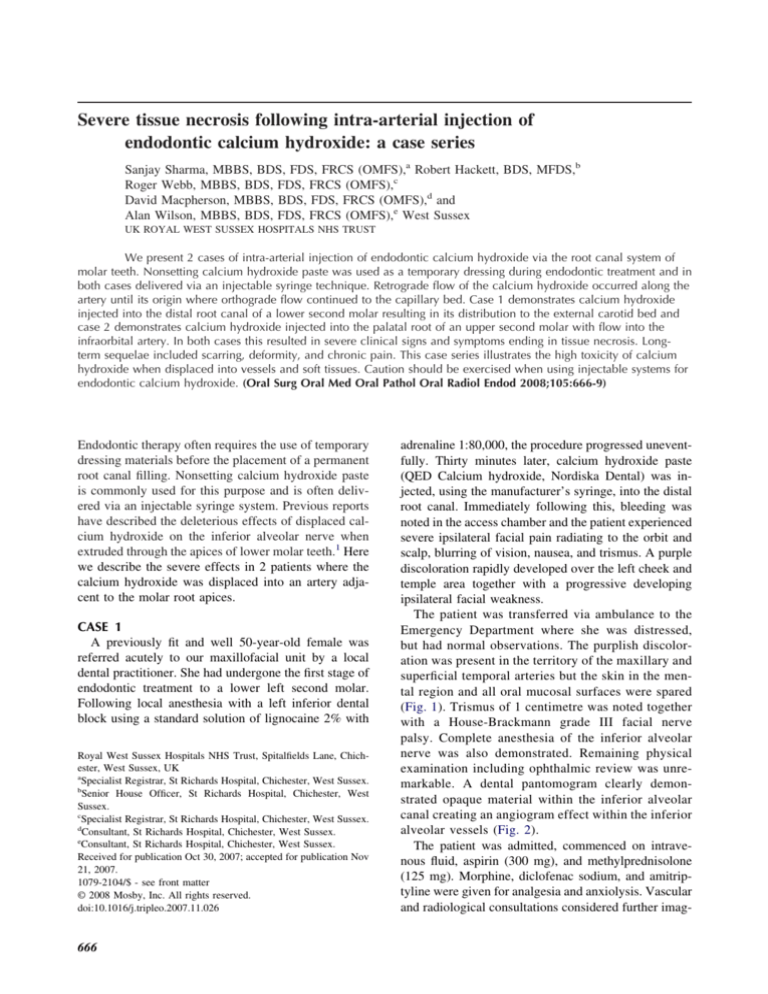
Severe tissue necrosis following intra-arterial injection of
endodontic calcium hydroxide: a case series
Sanjay Sharma, MBBS, BDS, FDS, FRCS (OMFS),a Robert Hackett, BDS, MFDS,b
Roger Webb, MBBS, BDS, FDS, FRCS (OMFS),c
David Macpherson, MBBS, BDS, FDS, FRCS (OMFS),d and
Alan Wilson, MBBS, BDS, FDS, FRCS (OMFS),e West Sussex
UK ROYAL WEST SUSSEX HOSPITALS NHS TRUST
We present 2 cases of intra-arterial injection of endodontic calcium hydroxide via the root canal system of
molar teeth. Nonsetting calcium hydroxide paste was used as a temporary dressing during endodontic treatment and in
both cases delivered via an injectable syringe technique. Retrograde flow of the calcium hydroxide occurred along the
artery until its origin where orthograde flow continued to the capillary bed. Case 1 demonstrates calcium hydroxide
injected into the distal root canal of a lower second molar resulting in its distribution to the external carotid bed and
case 2 demonstrates calcium hydroxide injected into the palatal root of an upper second molar with flow into the
infraorbital artery. In both cases this resulted in severe clinical signs and symptoms ending in tissue necrosis. Longterm sequelae included scarring, deformity, and chronic pain. This case series illustrates the high toxicity of calcium
hydroxide when displaced into vessels and soft tissues. Caution should be exercised when using injectable systems for
endodontic calcium hydroxide. (Oral Surg Oral Med Oral Pathol Oral Radiol Endod 2008;105:666-9)
Endodontic therapy often requires the use of temporary
dressing materials before the placement of a permanent
root canal filling. Nonsetting calcium hydroxide paste
is commonly used for this purpose and is often delivered via an injectable syringe system. Previous reports
have described the deleterious effects of displaced calcium hydroxide on the inferior alveolar nerve when
extruded through the apices of lower molar teeth.1 Here
we describe the severe effects in 2 patients where the
calcium hydroxide was displaced into an artery adjacent to the molar root apices.
CASE 1
A previously fit and well 50-year-old female was
referred acutely to our maxillofacial unit by a local
dental practitioner. She had undergone the first stage of
endodontic treatment to a lower left second molar.
Following local anesthesia with a left inferior dental
block using a standard solution of lignocaine 2% with
Royal West Sussex Hospitals NHS Trust, Spitalfields Lane, Chichester, West Sussex, UK
a
Specialist Registrar, St Richards Hospital, Chichester, West Sussex.
b
Senior House Officer, St Richards Hospital, Chichester, West
Sussex.
c
Specialist Registrar, St Richards Hospital, Chichester, West Sussex.
d
Consultant, St Richards Hospital, Chichester, West Sussex.
e
Consultant, St Richards Hospital, Chichester, West Sussex.
Received for publication Oct 30, 2007; accepted for publication Nov
21, 2007.
1079-2104/$ - see front matter
© 2008 Mosby, Inc. All rights reserved.
doi:10.1016/j.tripleo.2007.11.026
666
adrenaline 1:80,000, the procedure progressed uneventfully. Thirty minutes later, calcium hydroxide paste
(QED Calcium hydroxide, Nordiska Dental) was injected, using the manufacturer’s syringe, into the distal
root canal. Immediately following this, bleeding was
noted in the access chamber and the patient experienced
severe ipsilateral facial pain radiating to the orbit and
scalp, blurring of vision, nausea, and trismus. A purple
discoloration rapidly developed over the left cheek and
temple area together with a progressive developing
ipsilateral facial weakness.
The patient was transferred via ambulance to the
Emergency Department where she was distressed,
but had normal observations. The purplish discoloration was present in the territory of the maxillary and
superficial temporal arteries but the skin in the mental region and all oral mucosal surfaces were spared
(Fig. 1). Trismus of 1 centimetre was noted together
with a House-Brackmann grade III facial nerve
palsy. Complete anesthesia of the inferior alveolar
nerve was also demonstrated. Remaining physical
examination including ophthalmic review was unremarkable. A dental pantomogram clearly demonstrated opaque material within the inferior alveolar
canal creating an angiogram effect within the inferior
alveolar vessels (Fig. 2).
The patient was admitted, commenced on intravenous fluid, aspirin (300 mg), and methylprednisolone
(125 mg). Morphine, diclofenac sodium, and amitriptyline were given for analgesia and anxiolysis. Vascular
and radiological consultations considered further imag-
OOOOE
Volume 105, Number 5
ing including computed tomography (CT), magnetic
resonance imaging (MRI) and angiography but all were
rejected in view of risk benefit ratio. The use of thrombolysis and prostacyclin infusions were thought to be of
limited value.
The patient was discharged 3 days later. The facial
Fig. 1. Appearance on admission. Note the distribution of the
skin discoloration and left-sided facial nerve weakness.
Sharma et al. 667
nerve weakness and trismus had improved and analgesia requirements reduced. The affected skin remained
ischemic but with no evidence of necrosis. At review a
week later, further evidence of regional ischemic injury
was noted with large ulcerated areas present in the
mucosa of the ipsilateral hard palate and upper buccal
gingivae (Fig. 3). These were managed with chlorhexidine and benzydamine mouthwashes.
At 2 months, paresthesia in the inferior alveolar
nerve was demonstrable and the majority of affected
skin had recovered. However an exudative scab within
the hair-bearing scalp required exploration and an 8 ⫻
8 cm of full thickness area of necrotic skin was removed (Fig. 4). This area was left to heal by secondary
intention, and reconstruction to replace hair-bearing
scalp may be considered in the future.
CASE 2
A 55-year-old gentleman was undergoing routine
endodontic treatment to the upper left second molar at
his general dental practice. The root canals had been
instrumented with hand files and nonsetting calcium
hydroxide paste was injected into the palatal root canal.
The patient immediately experienced a sharp, severe,
well-localized pain in the left anterior maxillary region
and left hard palate. The calcium hydroxide dressing
was stopped and the dentist immediately irrigated the
canal with 40 mL of normal saline. The patient attended
the accident and emergency department later that day
and on examination was found to have left infra-orbital
swelling and bruising, tenderness over the anterior
maxilla, and pallor of the ipsilateral hard palate (Fig. 5).
There was anesthesia in the distribution of the infraorbital nerve.
Plain radiographs revealed an arteriogram appearance with radiopaque material within the confines of
Fig. 2. Orthopantomogram showing radiopaque material in the left inferior alveolar canal.
668
OOOOE
May 2008
Sharma et al.
Fig. 5. Ipsilateral pallor of hard palate.
Fig. 3. Palatal ulceration at 2 weeks.
Fig. 4. Widespread loss of full thickness scalp following
debridement.
the posterior superior alveolar artery and the infraorbital artery. Foreign material could not be detected
within the greater palatine artery despite the clinical
appearances. A computerized tomography (CT) scan
with 3-dimensional (3-D) reconstruction confirmed the
distribution of the material (Fig. 6).
The patient was admitted and given methyl prednisolone, aspirin, low molecular weight heparin, and
prophylactic antibiotics. The use of thrombolytic therapy and prostacyclin analogues was thought to be of
limited value and therefore not used.
The patient was discharged after 48 hours and asked
to continue with the aspirin and steroids for a further 5
days. At 1 week review the patient still experienced
chronic pain in the left anterior maxillary region, which
now showed increased bruising. The mucosa on the left
hard palate was still pale and several areas of superficial
Fig. 6. 3-D CT reconstruction of intravascular course of
calcium hydroxide (lateral view).
ulceration were noted along the palatal gingival margins.
At 1 month the ulceration had healed and sensation
was beginning to return in the infra-orbital nerve distribution. However, the problem of chronic debilitating
pain in the left maxilla still affects the patient and has
probably been a trigger for his recently diagnosed reactionary depression.
DISCUSSION
Calcium hydroxide paste is able to induce intense
inflammatory responses leading to necrotic and degen-
OOOOE
Volume 105, Number 5
erative changes in animal models.2,3 The pH of most
calcium hydroxide pastes is approximately 12. Exposure to blood results in crystalline precipitation due to
the intensely differing pH values. Theoretically, it cannot be considered a totally biocompatible material.
These cases both demonstrate how a communication
can be formed between the molar root apex and adjacent artery. Instrumentation may develop a traumatic
communication to facilitate the passage of material into
the artery. The syringe technique is then able to generate pressures higher than the intra-arterial pressure in
order to get retrograde flow along the artery. Once
material reaches its origin and is displaced into the stem
artery the orthograde flow will carry the material distally. Both of these cases show evidence of tissue
damage with areas of ischemia and tissue necrosis.
Arterial obstruction alone is unlikely to be responsible
for this phenomenon as the collateral circulation almost
always able to compensate. We hypothesis that the
necrosis must be due to calcium hydroxide reaching the
capillary bed and causing a direct tissue toxicity. In
Case 1 this occurred in the scalp, skin, and mucosa and
in Case 2 the effect on the infra-orbital nerve and
palatal mucosa was most obvious.
We treated our patients with aspirin, heparin, steroids, and prophylactic antibiotics. We feel that aspirin
and heparin would be adequate to prevent propagation
of existing thrombus. Steroid therapy would limit inflammatory damage and lessen neuronal injury, antral
obstruction, and hence pain. Antibiotics were used to
prevent infection of deep necrotic tissue. Thrombolysis
and prostacyclin analogues have been tried previously.
Lindgren et al.4 described a case of calcium hydroxide
injected via the root of a lower second molar and into
the maxillary artery bed causing necrosis of the earlobe
and superficial necrosis of the cheek skin. They treated
Sharma et al. 669
the patient with a tissue plasminogen activator and a
prostacyclin analogue. Using laser Doppler blood flow
measurements they found no improvement in flow rates
after treatment. This may be explained by the direct
toxic effects of calcium hydroxide at the cellular level.
We have been able to highlight the dangers of calcium hydroxide when injected into root canals and have
demonstrated the severe and long-lasting consequences. Caution should be exercised when using injectable systems for endodontic calcium hydroxide. Alternative dispensing routes should be used to prevent
extra-radicular deposit of the calcium hydroxide slurry.
We thank Dr. Max Hookway for the 3-D CT reconstruction image and Mr. Robert Derret for the photographic
images.
REFERENCES
1. Ahlgren FK, Johannessen AC, Hellem S. Displaced calcium hydroxide paste causing inferior alveolar nerve paraesthesia: report
of a case. Oral Surg Oral Med Oral Pathol Oral Radiol Endod.
2003;96(6):734-7.
2. Nelson Filho P, Silva LA, Leonardo MR, Utrilla LS, Figueiredo F.
Connective tissue responses to calcium hydroxide-based root canal medicaments. Int Endod J 1999;32(4):303-11.
3. Shimizu T, Kawakami T, Ochiai T, Kurihara S, Hasegawa H.
Histopathological evaluation of subcutaneous tissue reaction in
mice to a calcium hydroxide paste developed for root canal
fillings. J Int Med Res 2004;32(4):416-21.
4. Lindgren P, Eriksson K, Ringberg A. Severe facial ischemia after
endodontic treatment. J Oral Maxillofacial Surg 2002;60(5):
576-9.
Reprint requests;
Robert Hackett, BDS, MFDS
Department of Oral & Maxillofacial Surgery
Royal West Sussex Hospitals NHS Trust
Spitalfields Lane, Chichester
West Sussex, PO19 6SE, UK.
rob_hackett@hotmail.co.uk


